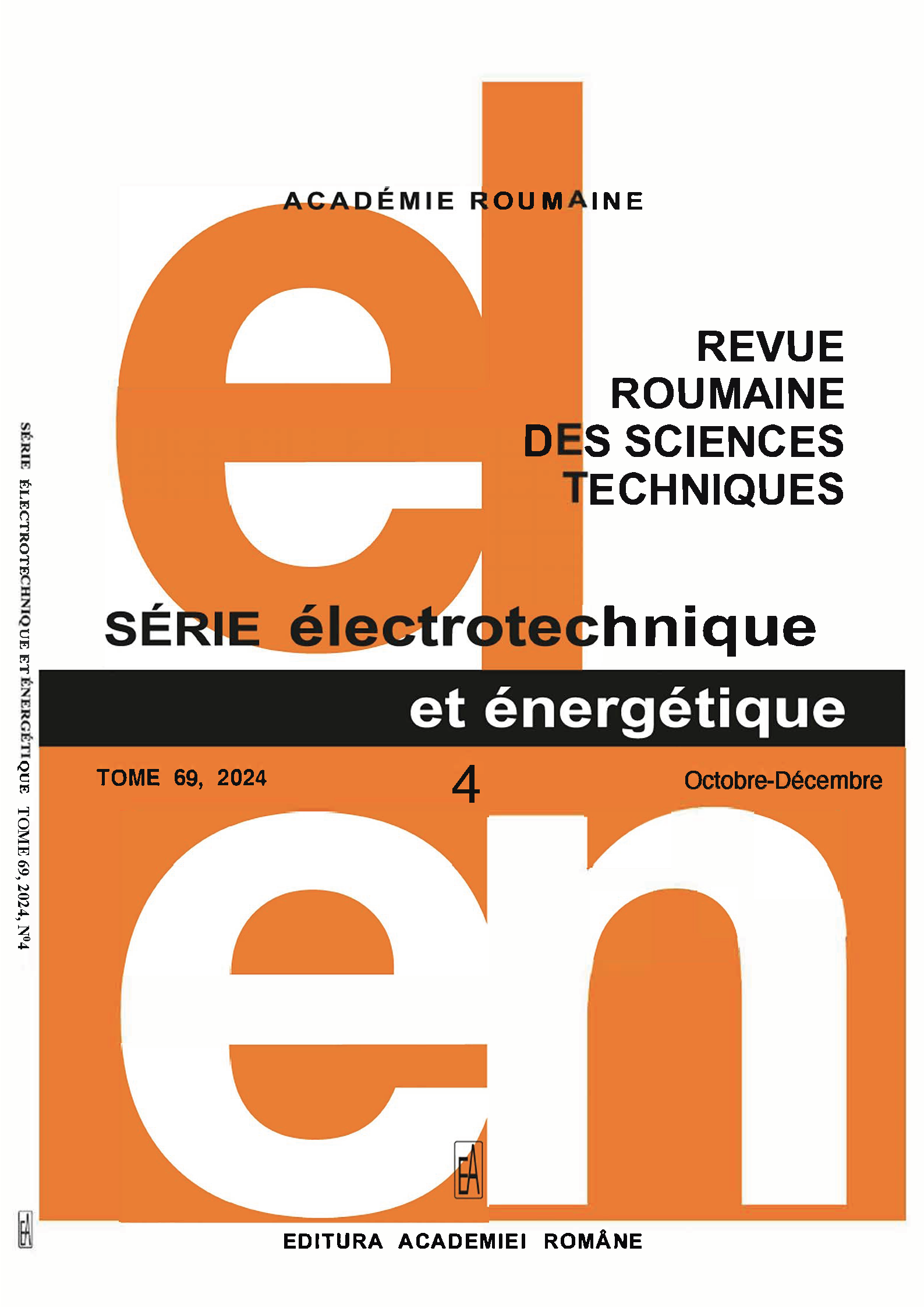GIANT TREVALLY OPTIMIZED CONGESTION MANAGEMENT USING FACTS CONTROLLER ALLOCATION IN DEREGULATED ELECTRICITY MARKETS
DOI:
https://doi.org/10.59277/RRST-EE.2024.69.4.2Keywords:
Deregulated power system, Congestion, Flexible alternating current transmission system (FACTS) devices, Giant trevally optimizer, Power lossAbstract
One of the technical issues arising from deregulation is transmission line congestion. The size and location of FACTS controllers like thyristor-controlled series compensators (TCSCs) and static VAR compensator (SVC) devices significantly affect their efficiency in congestion management problems. As a nonlinear problem, locating and sizing these devices in a power network is difficult. To solve this issue, this paper presents the technique for optimal FACTS placement using the giant trevally optimizer (GTO) algorithm for congestion management (CM). Three objective functions are considered to reduce the congestion, including voltage stability and eliminating real power loss overall cost. To determine the best location for FACTS devices in the MATLAB R2020b tool, the suggested GTO approach is implemented and discussed for the IEEE 14-bus and IEEE 30-bus systems. It is also compared with existing GSA, BBO, and ICSA approaches under three loading situations. From the simulation results, GTO minimized total costs and real power losses better than existing algorithm algorithms, and GTO provides high net saving costs.
References
(1) J. Morsali, K. Zare, M.T. Hagh, A novel dynamic model and control approach for SSSC to contribute effectively in AGC of a deregulated power system, International Journal of Electrical Power & Energy Systems, 95, pp. 239-253 (2018).
(2) A. Rabiee, H. Shayanfar, N. Amjady, Multiobjective clearing of reactive power market in deregulated power systems. Applied energy, 86, 9, pp.1555-1564 (2009).
(3) S. Dhundhara, Y.P. Verma, Capacitive energy storage with optimized controller for frequency regulation in realistic multisource deregulated power system, Energy, 147, pp.1108-1128 (2018).
(4) H. Besharat, S.A. Taher, Congestion management by determining optimal location of TCSC in deregulated power systems, International Journal of Electrical Power & Energy Systems, 30, 10, pp.563-568 (2008).
(5) S.S. Reddy, M.S. Kumari, M. Sydulu, Congestion management in deregulated power system by optimal choice and allocation of FACTS controllers using multi-objective genetic algorithm, In IEEE PES T&D 2010, pp. 1-7 (2010).
(6) M.T. Khan, A.S. Siddiqui, Congestion management in deregulated power system using FACTS device, International Journal of System Assurance Engineering and Management, 8, pp.1-7 (2017).
(7) M. Gitizadeh, M. Kalantar, A new approach for congestion management via optimal location of FACTS devices in deregulated power systems, In 2008 third international conference on electric utility deregulation and restructuring and power technologies, pp. 1592-1597 (2008).
(8) S. Sivakumar, D. Devaraj, Congestion management in deregulated power system by rescheduling of generators using genetic algorithm, In 2014 international conference on power signals control and computations (EPSCICON), pp. 1-5 (2014).
(9) A.S. Siddiqui, M.T. Khan, F. Iqbal, Determination of optimal location of TCSC and STATCOM for congestion management in deregulated power system, International Journal of System Assurance Engineering and Management, 8, pp.110-117 (2017).
(10) K. Paul, P. Sinha, S. Mobayen, F.F. El-Sousy, A. Fekih, A novel improved crow search algorithm to alleviate congestion in power system transmission lines, Energy Reports, 8, pp.11456-11465 (2022).
(11) J. Srivastava, N.K. Yadav, Rescheduling‐based congestion management by metaheuristic algorithm: Hybridizing lion and moth search models, International Journal of Numerical Modelling: Electronic Networks, Devices and Fields, 35, 2, p.e2952.
(12) K. Paul, N. Kumar, P. Dalapati, Bat algorithm for congestion alleviation in power system network, Technology and Economics of Smart Grids and Sustainable Energy, 6, pp.1-18 (2021).
(13) A. Sharma, and S.K. Jain, Gravitational search assisted algorithm for TCSC placement for congestion control in deregulated power system, Electric Power Systems Research, 174, p.105874 (2019).
(14) S.R. Salkuti, S.C. Kim, Congestion management using multi-objective glowworm swarm optimization algorithm, Journal of Electrical Engineering & Technology, 14, pp.1565-1575 (2019).
(15) M.M. Kumar, A. Alli Rani, A.V. Sundaravazhuthi, A computational algorithm based on biogeography‐based optimization method for computing power system security constrains with multi-FACTS devices, Computational Intelligence, 36, 4, pp.1493-1511 (2020).
(16) M. Dashtdar, M. Najafi, M. Esmaeilbeig, Calculating the locational marginal price and solving optimal power flow problem based on congestion management using GA-GSF algorithm, Electrical Engineering, 102, 3, pp.1549-1566 (2020).
(17) J. Mahadevan, R. Rengaraj, A. Bhuvanesh, Application of multi-objective hybrid artificial bee colony with differential evolution algorithm for optimal placement of microprocessor-based FACTS controllers, Microprocessors and Microsystems, p.104239 (2021).
(18) K. Guerraiche, A.B. Abbou, L. Dekhici, Intelligent fault detection and location in electrical high-voltage transmission lines. Revue Roumaine des Sciences Techniques—Série Électrotechnique Et Énergétique, 69, 3, 269-276 (2024).
(19) F. Rafique, L. Fu, M.H.U. Haq, R. Mai, Automatic features extraction by transfer learning for transmission line protection: transfer learning for transmission lines protection, Revue Roumaine Des Sciences Techniques—Série Électrotechnique Et Énergétique, 68, 4, 339-344 (2023).
(20) S. Arockiaraj, B.V. Manikandan, A. Bhuvanesh, Fuzzy logic controlled Statcom with a series compensated transmission line analysis, Revue Roumaine Des Sciences Techniques—Série Électrotechnique Et Énergétique, 68, 3, pp.307-312 (2023).
(21) A.J. Gnana Malar, S. Sellamuthu, M. Ganga, N. Mahendran, S. Hoseinzadeh, A. Ahilan, Power system planning and cost forecasting using hybrid particle Swarm-Harris Hawks optimizations, Journal of Electrical Engineering & Technology, 19, 2, 1023-1031 (2024).
(22) C.S. Sabitha, H.K. Kalidindi, Deep learning based wearable device for older people monitoring system, International Journal of Data Science and Artificial Intelligence, 2, 1, 13-19 (2024).
(23) F. Ahmad, Enhancement of the Voltage Profile for an IEEE-14 Bus System by Using FACTS Devices, Applications of Computing, Automation and Wireless Systems in Electrical Engineering: Proceedings of MARC 2018 (pp. 1243-1257), Springer, Singapore. (2019)
(24) P.P. Biswas, P. Arora, R. Mallipeddi, P.N. Suganthan, B.K. Panigrahi, Optimal placement and sizing of FACTS devices for optimal power flow in a wind power integrated electrical network, Neural Computing, and Applications, 33, pp .6753-6774 (2021).
(25) M.H. Sulaiman, Z. Mustaffa, Optimal placement and sizing of FACTS devices for optimal power flow using metaheuristic optimizers, Results in Control and Optimization, 8, p.100145 (2022).
Downloads
Published
Issue
Section
License
Copyright (c) 2024 REVUE ROUMAINE DES SCIENCES TECHNIQUES — SÉRIE ÉLECTROTECHNIQUE ET ÉNERGÉTIQUE

This work is licensed under a Creative Commons Attribution-NonCommercial-NoDerivatives 4.0 International License.


